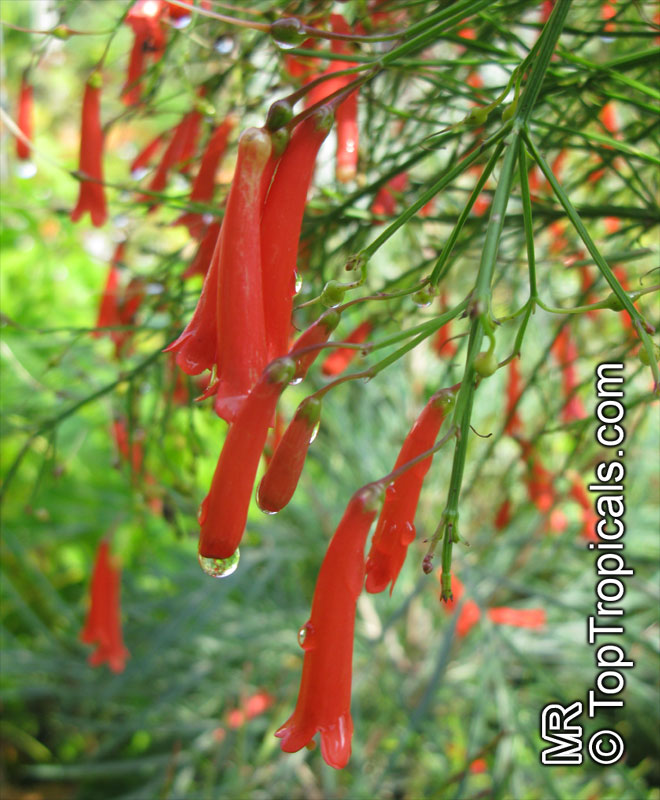Russelia Firecracker
Native to Mexico, Coral Plant (Russelia equisetiformis) is a highly ornamental shrub with slender, wispy stems spilling out like a waterfall and ablaze with clusters of bright, coral-red tubular flowers, which attract hummingbirds and butterflies. Long clusters of firecracker-like flowers, 1-inch-long hang at the branch tips.
Culture Winter hardy to USDA Zones 9-11. Louis, grow in pots or hanging baskets which should be overwintered indoors. Easily grown in average, medium, well-drained soils in full sun. Tolerates a wide range of soil moisture. Established plants tolerate some dry soils, but are best in medium moisture soils. Also grows well in moist soils at the periphery of ponds or water gardens.
Pollen Vectors Of Russelia Firecracker
Site in locations sheltered from strong winds. Cascading stems may root where they touch the ground, either accidentally or by design, and new plants can be potted up when this occurs. Overwinter as a houseplant in a warm sun room (if well sited, it may continue to bloom throughout winter) or force into dormancy by cutting stems back hard and storing in a dark, cool, dry corner of a basement or frost free garage. Stems of overwintered houseplants may be pruned or cut back to the soil level in spring in advance of placing pots outdoors. Noteworthy Characteristics Russelia equisetiformis, commonly called coral plant, coral fountain or firecracker plant, is native to Mexico. It is a deciduous, asparagus-like, many-branched, tropical subshrub (to 4’ tall) with trailing rush-like 4-angled stems and bright red tubular firecracker-like flowers (to 1.25” long) in drooping terminal cymes. Blooms freely from late spring to frost.
Needle-like medium green leaves (to 1/2” long). Flowers are attractive to hummingbirds. Synonymous with R.
Genus name honors Dr. Alexander Russell ( c.

1715-1768), physician to the English Factory at Aleppo. Specific epithet means like the genus Equisetum (horsetail).
The narrow, tubular flowers are about 1 in (2.5 cm) long and cover the plant from late spring till fall. Actually, it can flower any time of year, given enough warmth and light. You'll get the most blooms by putting it in full sun. Moving it outdoors for the summer is ideal. It's attractive to passersby as well as to butterflies and hummingbirds. This is a frost-tender plant. In fact, it doesn't do well in cold temperatures, so be sure to bring it back indoors when the temperature drops in autumn.
Russelia equisetiformis may be hard to find in garden centers, but is available for sale online. Many colors are available: red, yellow, orange, white and pink. Some popular named varieties include 'Salmon Pink', 'Yellow Gold' and 'Tangerine Falls'. Display your firecracker plant in a large hanging basket and allow it to cascade, showing off the fine-textured foliage covered with bright flower clusters.
Give it some space, too. This spectacular, many-branching shrub can spread as wide as it is tall. Prune it back. By pruning off stems that have already flowered, you'll get more flowers! Cut off spent flower stems at the base anytime.
To keep your plant a manageable size, prune it back hard in early spring. Bring it in. This shrub is an evergreen perennial that's frost-tender. Unless you live in a year-round warm climate, expect to overwinter it indoors. Keep it in a warm, sunny location. Reduce watering because growth will slow down in winter. Firecracker Plant Care Tips. Origin: Mexico Height: 3-6 ft (90 cm - 1.8 m) tall; trails to 6 ft (1.8 m) Light: Bright light to full sun.

Firecracker plants require lots of light to bloom. Move it outdoors for the summer and set it in the sunniest spot you can provide. Water: Water thoroughly, allowing the top of the soil to dry out between waterings. Mature plants are drought-tolerant, so it's a good idea to keep them on the dry side. Humidity: Average room humidity Temperature: Average room temperatures 65-75°F/18-24°C. If you move your plant outside for the warm months, don't worry - it can take the heat.
It's hardy in USDA Zones 9b-11. It won't tolerate freezing temperatures. Soil: Any good potting mix with a little added perlite or sand for quick drainage. Fertilizer: Feed every 2 weeks spring through fall with a balanced liquid fertilizer diluted by half. In winter, feed monthly. Propagation: Take stem tip cuttings in spring.